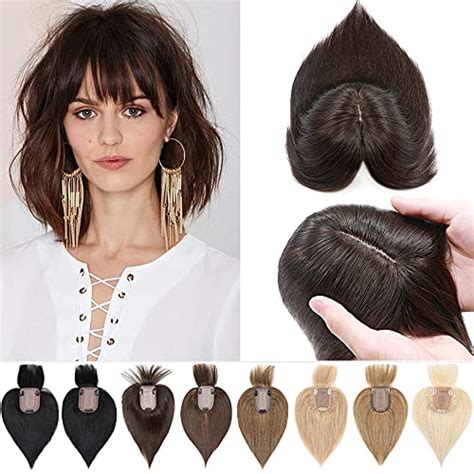Hair loss, medically known as alopecia, is a common concern affecting both men and women. While there are numerous causes of hair loss, such as genetics, hormonal changes, and medical conditions, it can significantly impact individuals’ self-esteem and overall well-being.

Hair loss toppers, also known as hairpieces or wigs, have emerged as a popular solution for those experiencing hair thinning or partial baldness. These toppers are designed to seamlessly blend with your natural hair, adding volume and coverage to areas where hair growth is sparse or absent.
Benefits of Hair Loss Toppers
-
Natural-looking coverage: Toppers are typically made from human hair or synthetic fibers that mimic the texture and color of your natural hair, ensuring a seamless blend.
-
Added volume and fullness: Toppers instantly add thickness and fullness to thinning hair, creating the illusion of a thicker, more voluminous mane.
-
Concealment of hair loss: Toppers effectively cover areas of hair loss or thinning, providing a discreet and customizable solution to enhance your overall hair appearance.
-
Convenience and flexibility: Toppers are easy to apply and remove, offering a convenient way to change your hairstyle or add coverage whenever needed.
-
Boost in confidence and well-being: Regaining volume and concealing hair loss can significantly enhance self-esteem and overall well-being, reducing the emotional distress associated with hair thinning.
Types of Hair Loss Toppers
There are various types of hair loss toppers available, each designed to suit different needs and preferences:
| Type | Description | Pros | Cons |
|---|---|---|---|
| Clip-in Toppers | Attach directly to your hair using clips | Easy to apply and remove | May require adjustments for a secure fit |
| Tape-in Toppers | Adhere to your hair using tape or adhesive | Provides a more secure and longer-lasting fit | May cause damage to natural hair upon removal |
| Wefted Toppers | Sewn onto your natural hair | Most permanent option but requires professional installation | Can be time-consuming and expensive |
| Mono Toppers | Made with a thin, breathable base material | Mimics the appearance of a natural scalp | More expensive than other types |
Choosing the Right Hair Loss Topper
Selecting the ideal hair loss topper involves considering several factors:
-
Size: Measure the area of hair loss or thinning to determine the appropriate size of the topper.
-
Color: Choose a topper that closely matches your natural hair color to ensure a seamless blend.
-
Texture: Match the texture of your natural hair to achieve a natural-looking result.
-
Length: Consider the desired length of the topper based on your personal style and hair growth patterns.
-
Quality: Invest in a high-quality topper made from durable materials for a longer lifespan and better results.
Tips for Using Hair Loss Toppers
-
Prepare your hair: Wash and dry your natural hair thoroughly before applying the topper.
-
Securely attach: Follow the manufacturer’s instructions for the chosen attachment method to ensure a secure and comfortable fit.
-
Style as desired: You can style the topper with heat tools, hairspray, or other styling products to match your natural hair.
-
Regular cleaning: To maintain the topper’s condition, wash it regularly using a gentle shampoo and conditioner specifically designed for synthetic or human hair.
-
Proper storage: Store the topper in a cool, dry place when not in use to prolong its lifespan.
FAQs about Hair Loss Toppers
1. Are hair loss toppers harmful to my natural hair?
Tape-in toppers may cause minimal damage to natural hair upon removal, but other types, such as clip-in and mono toppers, are generally considered safe for use.
2. How long do hair loss toppers last?
With proper care and maintenance, hair loss toppers can last for several months to a year or more.
3. Are hair loss toppers noticeable?
High-quality toppers, properly matched and applied, can blend seamlessly with natural hair, making them barely noticeable.
4. Can I sleep in a hair loss topper?
While some toppers are designed for overnight wear, it’s generally not recommended to sleep in a topper as it may cause discomfort or damage to the hairpiece.
5. How much do hair loss toppers cost?
The cost of hair loss toppers varies depending on the type, size, quality, and materials used. Expect to pay anywhere from $100 to $1,000 or more for a high-quality topper.
6. Can I dye a hair loss topper?
While some toppers can be dyed, it’s essential to consult a professional hairstylist to avoid damaging the hairpiece.
7. How often should I clean my hair loss topper?
For regular use, it’s recommended to wash your topper every 4-6 weeks or more frequently if necessary.
8. Where can I find a reputable supplier of hair loss toppers?
Research reputable suppliers online or consult with a hair loss specialist or stylist for recommendations.
